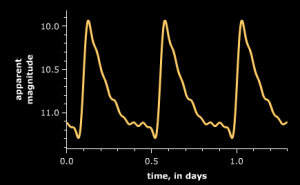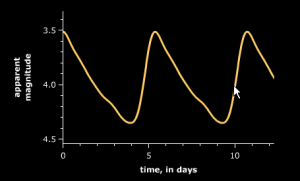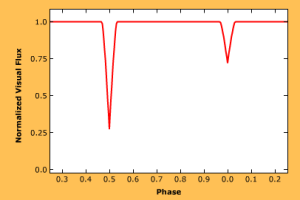Variable Stars
Variable stars are stars that appear to vary in brightness over time. There are many different underlying causes of variability. For many types of these stars, the variation in brightness regularly repeats and the periods range from a couple of hours to hundreds of days. Variable stars are vitally important in astronomy for the information they can provide on the properties of stars.
One important group of variable stars is pulsating variable stars. These stars are known as intrinsic variables since they actually pulsate – their radii rhythmically expand and shrink – much like breathing. As the radius changes, the surface temperature changes as well, leading to a change in luminosity. These stars are brightest near their minimum size, which corresponds to their maximum temperature. Note that the energy production in the cores of these stars remains constant – they vary in brightness because of periodic changes in the energy release in the outer parts of the stars. Characteristics of the two main types of pulsating stars are summarized in the table below.



| Type | Period | Mass M |
Amplitude | Spectral Class |
|---|---|---|---|---|
| RR Lyrae | 1.5 – 24 hours | 0.5 – 0.7 | 0.3 – 2 mags | A2 to F6 |
| Cepheid | 1 – 50 days | 3 – 18 | 0.5 – 2 mags | F6 to K2 |
Several cycles of three pulsating variable stars are shown in the graphs to the right. The particular RR Lyrae sub-type shown in the top pane is known as an RRab star which has a large amplitude asymmetric light curve and its period tends to be toward the large end of the RR Lyrae range. An RRc star is shown in the central pane. The variation in brightness due to its pulsation is more sinusoidal, smaller in amplitude, and its period tends to be toward the short end of the RR Lyrae range. The variation for a Cepheid variable is shown in the bottom pane. This is a larger more massive star which has a longer period than the RR Lyrae stars.
Observations of variable stars are normally presented in the form of a light curve. This is a graph of brightness versus phase. Phase is a quantity between 0.0 and 1.0 and describes the place in the cycle of variation where the data point is located. It is equal to the decimal portion of the time of the observations after dividing by the period. Note that it is necessary to know the period of the variable to form the light curve.
A second major type of variable ‘star’ is an eclipsing binary system. Even though such a ‘star’ looks like a single point of light through the telescope it is in fact a pair of gravitationally bound stars in close orbit around each other. If the orbital plane of these stars is inclined towards the earth then we can see the light level dip as one star eclipses (passes in front of) the other. Since the stars themselves do not change in brightness we refer to these types of stars as extrinsic variables.

The light curve for an eclipsing binary is shown to the left. Note this is truly a light curve as it is graphed in terms of phase. The data for a number of cycles have been combined to show cycle of the variation in light. The light curves for these stars span a wide range of appearances. However, one common appearance has a flat maximum light portion representing the combined light from both stars and then two eclipses where one star is cutting in front of the other.
Additional information on light curves and calculating phase is available in the NAAP Eclipsing Binary Simulator Module.